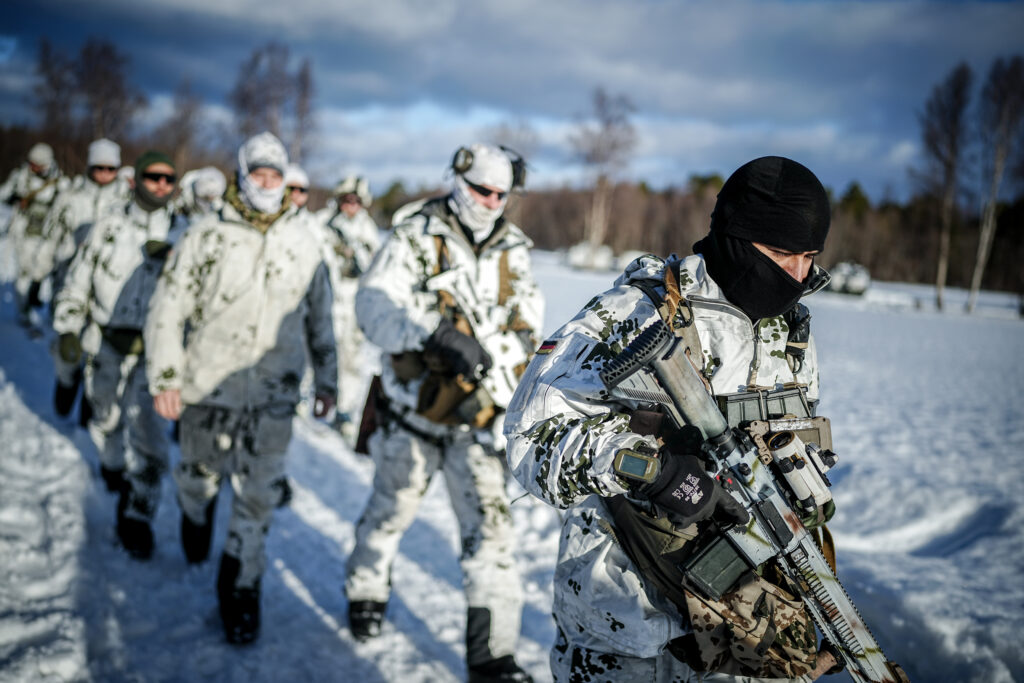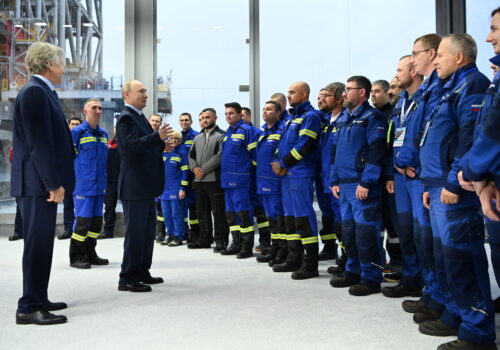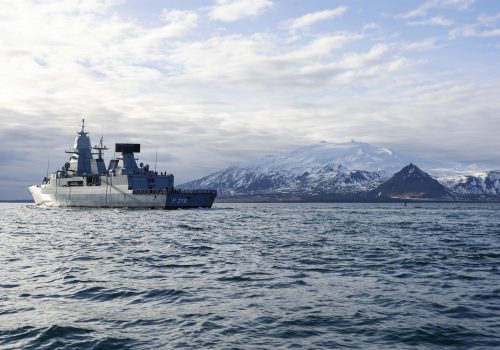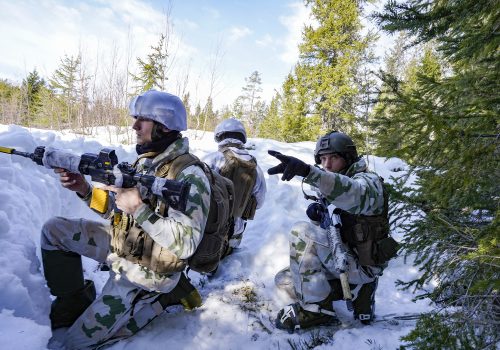Last month’s Russian and Chinese joint bomber patrols along the Alaskan coast signaled a new front of concerted action by the United States’ leading adversaries along its northern border. The growing coordination between China and Russia in the Arctic represents a clear and present danger to the United States and its regional allies, and calls for a commensurate response in strategy, resources, and coordination.
The United States, consistent with its commitment to a free and open Indo-Pacific, should rally its NATO allies in the cause of a “Free North” to deter China’s and Russia’s “no limits” partnership from taking hold at the doorstep of United States and Europe. The Free North framework builds upon and goes beyond in substance and symbolism the “monitor and respond” approach articulated in the 2024 Department of Defense Arctic Strategy. The Free North broadly refers to the Arctic region beyond Russia’s territorial seas. It encompasses the territorial waters of the United States and its allies, as well as the high seas. The Free North’s core principles are respect for national sovereignty and a commitment to the peaceful resolution of territorial disputes through mutual agreement. With changing climate patterns, an expanding area of the Arctic is ice-free in the summer months. This allows for greater access and exploration of the region for both legitimate and illicit ends. It is therefore in the United States’ and its allies’ interest to ensure that the region remains free.
Russian and Chinese cooperation
In the past, Russia jealously guarded its Arctic regions from China’s presence and influence. But Russia’s full-scale invasion of Ukraine and its resulting dependence on China’s economic lifeline has changed all that. Russia also finds China to be a useful partner in executing its Arctic Policy 2035, which aims to control a future northern sea route as an alternative to the Strait of Malacca and the Suez Canal for Asia-Europe commerce. Chinese flotillas with advanced surveillance capabilities are increasingly present across the Arctic. China is using fishing fleets, research vessels, mineral exploration, and naval infrastructure to pave the way for military installments across the Arctic with Russian cooperation.
It is prudent to expect China’s aggressive posture in the Arctic to emulate its tactics in South China Sea and the Pacific islands, with one big difference: In the Arctic, China has a large partner complementing its efforts—Russia. But the US-led coalition of northern democracies is well positioned to match and rebut the China-Russia nexus in the region.
From the United States to Finland, NATO allies represent a contiguous northern flank. Finland and Sweden’s NATO accessions have strengthened the Alliance and repositioned its regional security framework. Finland spans from the Arctic Circle to the Baltic, so along with the United States, it is optimally positioned to anchor a collective commitment to a Free North. The Baltic Sea, which is now nearly surrounded by NATO members, offers a resolute coalition of reinforcements for Arctic security.
A ‘Free North’ strategy
To execute an effective Free North strategy, the United States needs to prioritize four reinforcing lines of effort. First, it should establish and lead a NATO sub-group of Arctic-Baltic allies, which may additionally include the Netherlands and the United Kingdom, with a coordinated strategy delineating shared responsibilities. The United States should also convince the Arctic Council to adopt the Free North as an organizing framework for coordinated action.
Second, allies should enact an initiative among northern NATO members to adequately resource a Free North strategy with a requisite number of submarines, icebreakers, polar frigates, and air and space assets. This means building on the recently announced US-Canada-Finland Icebreaker Collaboration Effort, or the “ICE Pact,” to embark on an initiative closer in ambition and scope to the Australian-UK-US partnership known as AUKUS. The United States, with its comparative advantages, should lead allied efforts to manufacture and deploy submarine, air, and space assets. Finland and other European NATO members should manufacture icebreakers and polar frigates. Additionally, the United States and Europe, in close collaboration with Japan and South Korea, should rebuild the transatlantic and Indo-Pacific commercial shipbuilding industries to catalyze and complement their collective naval forces. This will help ensure the resilience and security of global supply chains.
Third, the United States should engage the Free North nations to execute a responsible regional conservation and development strategy with particular attention to energy and mineral exploration, critical infrastructure development and security, and sustaining free shipping lanes. Climate and ecological considerations should inform the Free North strategy but not disadvantage it vis-à-vis China’s and Russia’s aggressive energy and mineral exploration and development.
Fourth, the United States should double down on the development of Alaska and Greenland as cornerstones of its Free North strategy. Alaska is in urgent need of improved infrastructure and industrial capacity, as it represents the springboard for US Arctic operations across the full spectrum of defense and economic actions. Greenland, a semi-autonomous Danish territory, is historically dependent on US investments to develop its security and economic potential. The changing climate is rendering an ever-growing expanse of the world’s largest island accessible for resource exploration and development. China has been aggressive in its overtures to develop the island’s mineral resources. In response, the United States opened a consulate in Nuuk, Greenland’s capital, and committed development funds. But much more needs to be done to realize Greenland’s full potential in supporting the United States’ economic and security interests.
How the US can lead the way
Beyond these four components of the collective Free North strategy, there are additional actions the United States can take on its own to help secure the Arctic and Baltic regions. The United States should substantially augment its Coast Guard fleet. At least a three-fold increase of icebreakers and polar frigates in the Arctic alone will be necessary to secure the region. The US Coast Guard will be on the frontline of several growing challenges in the Free North, including but not limited to protecting critical infrastructure; securing sea lanes; combating illegal, unreported, and unregulated fishing; providing search and rescue and incident response; ensuring responsible minerals and energy development; and patrolling and surveillance.
Additionally, the US Congress should make permanent the diplomatic post of US ambassador-at-large for the Arctic region, which was established in 2022. This ambassador should improve coordination across the US defense and diplomatic offices overseeing the region. This diplomat should also engage with the National Security Council and the Pentagon to push for greater operational coordination and responsibilities across military combatant commands, including the Northern Command, European Command, and Indo-Pacific Command.
A Free North strategy calls for burden sharing and coordinated action among Arctic and Baltic nations. The Arctic and Baltic Seas share geographies, adversaries, and a contiguous bulwark of committed NATO members. Russia has long presented the primary potential security threat in the Arctic and Baltic with the ability to threaten a northern air and missile attack on the United States, Canada, or Europe. The frequency of Russian air patrols along US and Canadian airspace is on the rise. So is the presence of Chinese flotillas.
Russian and Chinese coordination presents the greatest threat to NATO in the Arctic. It would be imprudent to delay and dither while the malign intent of China and Russia take hold in the region. The central, unifying power of US leadership is indispensable in rallying NATO members from the Chukchi Sea to the Gulf of Finland to answer the call of the Free North for collective security.
Kaush Arha is president of the Free & Open Indo-Pacific Forum and a nonresident senior fellow at the Atlantic Council and the Krach Institute for Tech Diplomacy at Purdue.
Tom Dans is a former commissioner of the US Arctic Research Commission and former counselor to the under secretary for international affairs at the US Department of the Treasury.
Further reading
Tue, Jul 9, 2024
NATO needs a strategy to address Russia’s Arctic expansion
New Atlanticist By
The Washington summit this week provides the perfect moment for the Alliance to forge an even more unified approach to the future of security in the High North.
Wed, Sep 6, 2023
Alternative security futures in the High North
Issue Brief By David Auerswald
Climate change, combined with increasing geopolitical competition and hostilities, has focused renewed attention on national security interests in the Arctic. By 2035, how will those variables combine to influence the High North?
Wed, Jul 26, 2023
Arctic security is increasingly under threat. Drones can help.
New Atlanticist By Kirk Allen
Russia's invasion of Ukraine and climate change are fundamentally changing the Arctic; unmanned aircraft systems may help allies fill their security gaps in the region.
Image: Mountain infantry units of the German Armed Forces (Bundeswehr) are taking part in the NATO maneuvers "Nordic Response 2024", which are taking place in the Norwegian Arctic. Kay Nietfeld/DPA via Reuters Connect.



